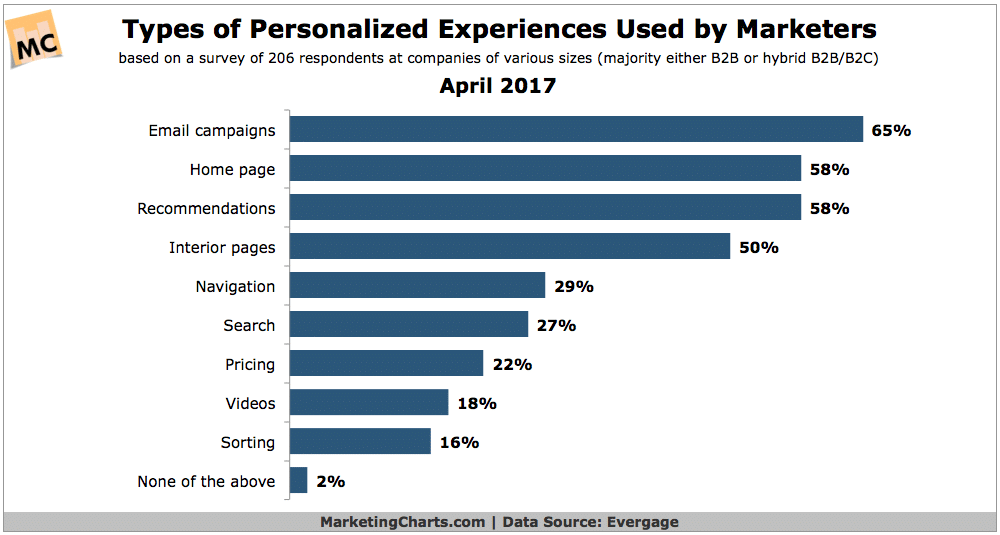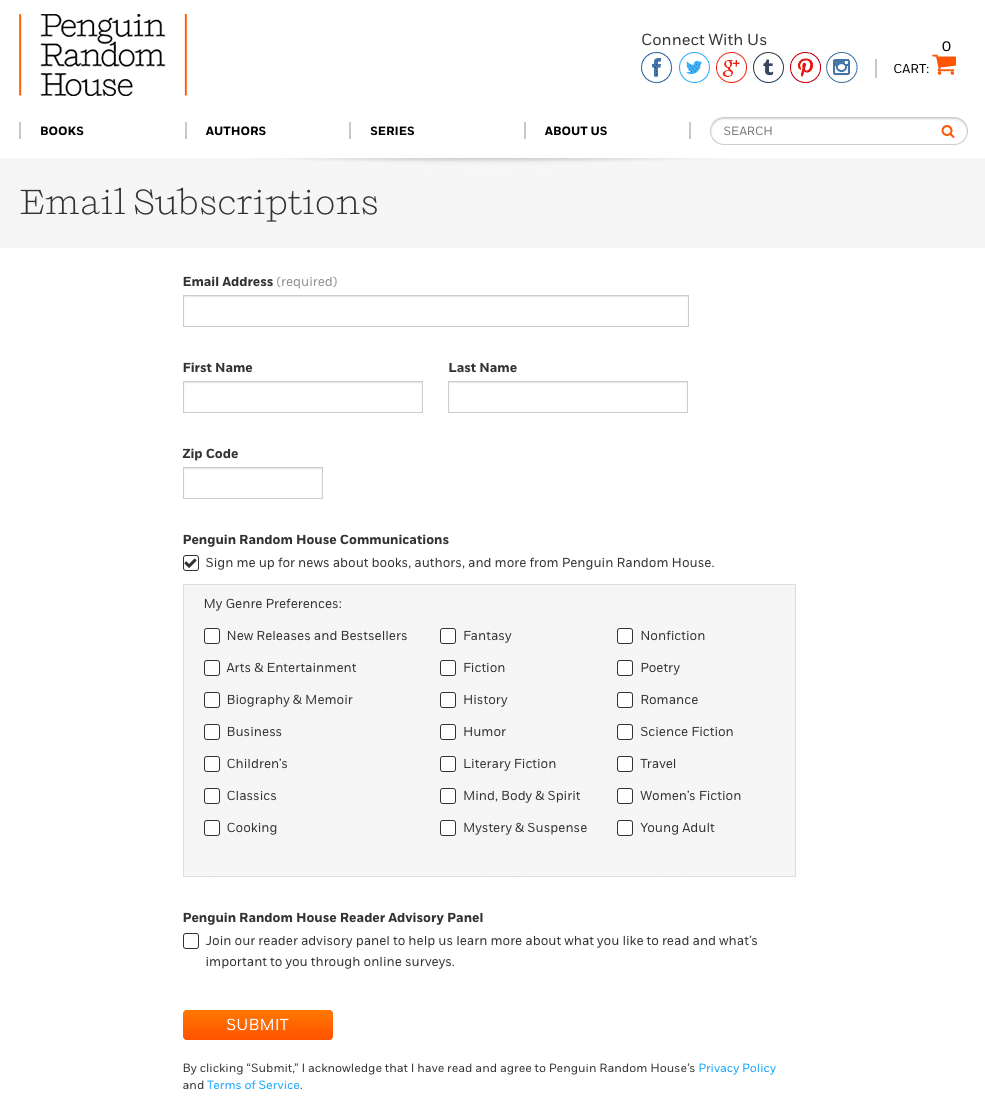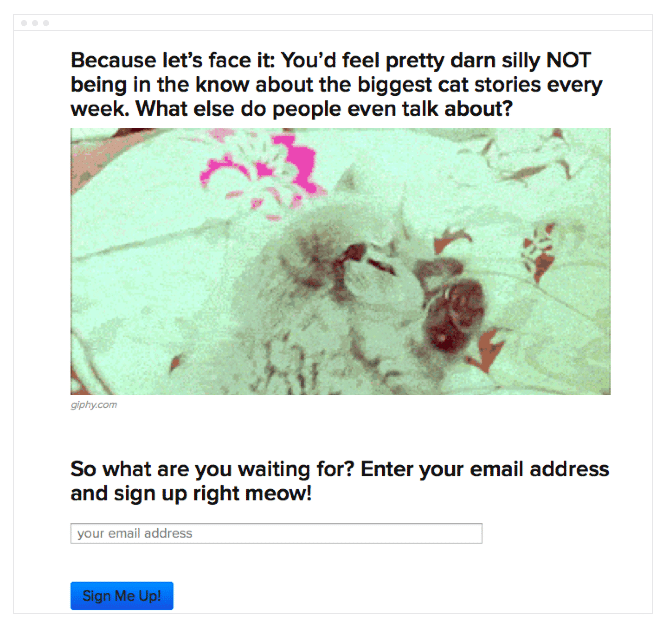Article first published January 2018, updated June 2019
In years past, personalization and segmentation may have been optional, but no more. In 2018, marketers have to meet expectations and that means creating relevant, personalized messages that subscribers want to read.
Research shows marketers lean on email marketing to create a personalized experience for customers, compared to other options:

There’s no question, there’s a lot of power behind personalization and segmentation. In this post, we’ll look at five ways it’s changing email marketing:
1. Increased revenue through advanced segmentation
Segmenting email contacts into specific groups can give your bottom line a boost. Marketers have noted a 760% increase in revenue from segmented campaigns, according to Campaign Monitor research.
Why does segmentation impact revenue? Grouping contacts by location, gender, age, job title, or buying history, gives you the opportunity to send emails that are more in-tune with what subscribers are interested in. As a result, subscribers are more apt to open your emails, click through, and convert.
For continued success, segment your segments. Start breaking your segmented lists into even smaller groups. For instance, take your ‘female customers’ list and create a list of ‘VIP female customers’ that buy from you regularly.
2. Better engagement through self-segmentation
Customers are embracing the idea of self-segmentation too. Rather than segment email contacts yourself, why not let subscribers do it for you?
Marketers are using email preference centers to give subscribers the power to select their interests. Penguin Random House directs its subscribers to the preference center below. It gives subscribers the power to self-select the book genres they’re most interested in. In return, subscribers receive emails that provide book suggestions they’re excited about.

Marketers are also giving website visitors the ability to join specific newsletters. BuzzFeed, gives visitors the chance to sign up for newsletters that are based on the content they read. For instance, if a visitor reads an article about cats, a form pops up asking the visitor to join a specific cat newsletter.

This kind of self-segmentation removes any doubt about categorizing a subscriber. As a result, engagement climbs because subscribers see content they want in their inbox.
3. Stronger relationships built through dynamic content
Marketers have figured out how to create personalized emails without spending a ton of time manually tweaking emails. How? Dynamic content.
Dynamic content allows marketers to create one email, but customize blocks of it for certain subscribers. Let’s say you’re hosting a sale at both of your stores in Fresno and Los Angeles. Through dynamic content, you can localize the images and content. The subscribers in Fresno see a picture of their local store and those in LA see their hometown store.
Dynamic content is personalized. When subscribers open the email they think, “This company gets me.” With every dynamically personalized email, you build a stronger relationship with your customer.
4. Eased workload via automation and integrations
The need to create more personalized content sounds like more work for marketers, right? It doesn’t have to be, if you’re using an email service provider that has automation features and useful integrations.
Automation is a must for marketers looking to save time. Using automation, you can send emails automatically. That’s right. You can set up triggers so emails that you pre-make are sent to subscribers when they meet a certain condition.
For instance, when a subscriber joins your newsletter that action can trigger a welcome email. When a subscriber makes a purchase, a confirmation email is triggered. You can even trigger emails based on a specific date, so a Valentine’s Day email can arrive in inboxes a week before the holiday.
In addition, marketers should lean into integrations.
Integrations let you sync platforms for ease of use. For instance, Campaign Monitor integrates with Facebook so you can add a subscribe form to your Facebook page and every contact collected flows into your Campaign Monitor account.
Campaign Monitor has a plethora of integrations including Magento, WooCommerce, Shopify and Receiptful, just to name a few.
It’s these simplified processes that have become crucial to marketers as they’re asked to personalize more and more campaigns.
5. An increasing need to collect data
To personalize emails, you have to know your customers. That means you have to collect data on an ongoing basis.
Marketers are getting more sophisticated when it comes to data collection. When a customer signs up for a webinar, downloads a white paper, makes a purchase, or interacts with a social ad, they’re asking for new pieces of information.
As information rolls in, marketers use the data to build customer personas. These personas are meant to help marketers visualize real customers with details that specify age, location, interest, buying activity, etc.
Every new piece of information strengthens a persona and helps marketers create tailored content.
Marketers weigh in: How personalization and segmentation are impacting campaigns
We asked marketers to tell us how personalization and segmentation are changing their strategies. From increased conversion rates to connecting with customers, here’s how these two tactics are improving the ROI of email marketing:
- Instead of a “spray and pray” email strategy, we now segment our database by emotional target or a reason why they contacted us. Personalizing all emails with content that is geared towards customers’ concerns creates a lasting bond between our brand and our potential audience.
Brannan Glessner, Express Homebuyers - What truly drives awesome email performance is a more personalized messaging strategy, one that adjusts the timing, cadence, and content of emails to segments built off our users’ captured behavioral data. With this approach, email is part of a conversation that begins at the inbox, but doesn’t end there.
Stephen Hammill, Anvil Media Inc. - We put a lot of strategy into segmenting our email, starting with detailed persona building to determine messaging. From there, we have in-depth interviews with our client’s sales side to identify common questions, concerns and pain points – and we’ve had great response rates as a result.
Louise Armstrong, Bonafide - As a higher education institution, we have multiple offices emailing prospective students. By adjusting our email strategy to be more personalized and sending emails segmented by age, location, and level of interest, we have seen a massive increase in open and click rates.
Lexi Carter, Southern Utah University - Personalization-at-scale is one of the most important digital trends in 2018. Brands can use the new breed of email marketing automation tools to capture audience attention at the right time, with personalized engagement for every touch-point in the customer journey. It’s still “selling,” but selling in a very efficient yet personalized way.
Alessio De Luca, Florence Consulting Group
Practical ways to improve your personalization and segmentation today
At this point, you should be convinced that the future of email marketing is in personalization. However, the question still remains: how do you execute this strategy in your email campaigns?Let’s quickly look at some practical ways you can improve your personalization and segmentation.
1. Get as much data as you can
Your ability to create highly segmented and personalized emails depends on your data-gathering abilities. Your signup form is limited when it comes to getting sufficient data, as you don’t want to overwhelm your customers by asking for too much information right at the onset.Creativity is the name of the game here. Aside from using tracking tools, you can also run contests that you use to gather more data. Another way is to give coupons and discount codes in exchange for more details about your customer. This will give you more data to improve your segments and, ultimately, create highly personalized campaigns.
2. Identify your segmentation criteria
Once you’ve gathered your data, identify how you can use it to create better segments. Some of the data will be common among your customers, but that doesn’t make it the best for your brand and business. Identify data that helps you create segments that address each of your customers as individuals.
3. Keep the customer journey in mind
Another great way of giving your customers a personalized experience is by segmenting them according to their position in the customer journey. This will help you to deliver the right content at the right time, thus increasing engagement and conversions.
Wrap up
As you can see, marketers are reaching new heights as they incorporate personalization and segmentation into their strategies. The two tactics have become a necessity for marketers looking to connect with customers in a digital world. In 2018, the trend will continue as customers’ expectations continue to rise.
Check out our article 6 Ways to Use Personalization In Your Next Email Campaign for more insight on how to use segmentation and personalization to increase customer engagement.





